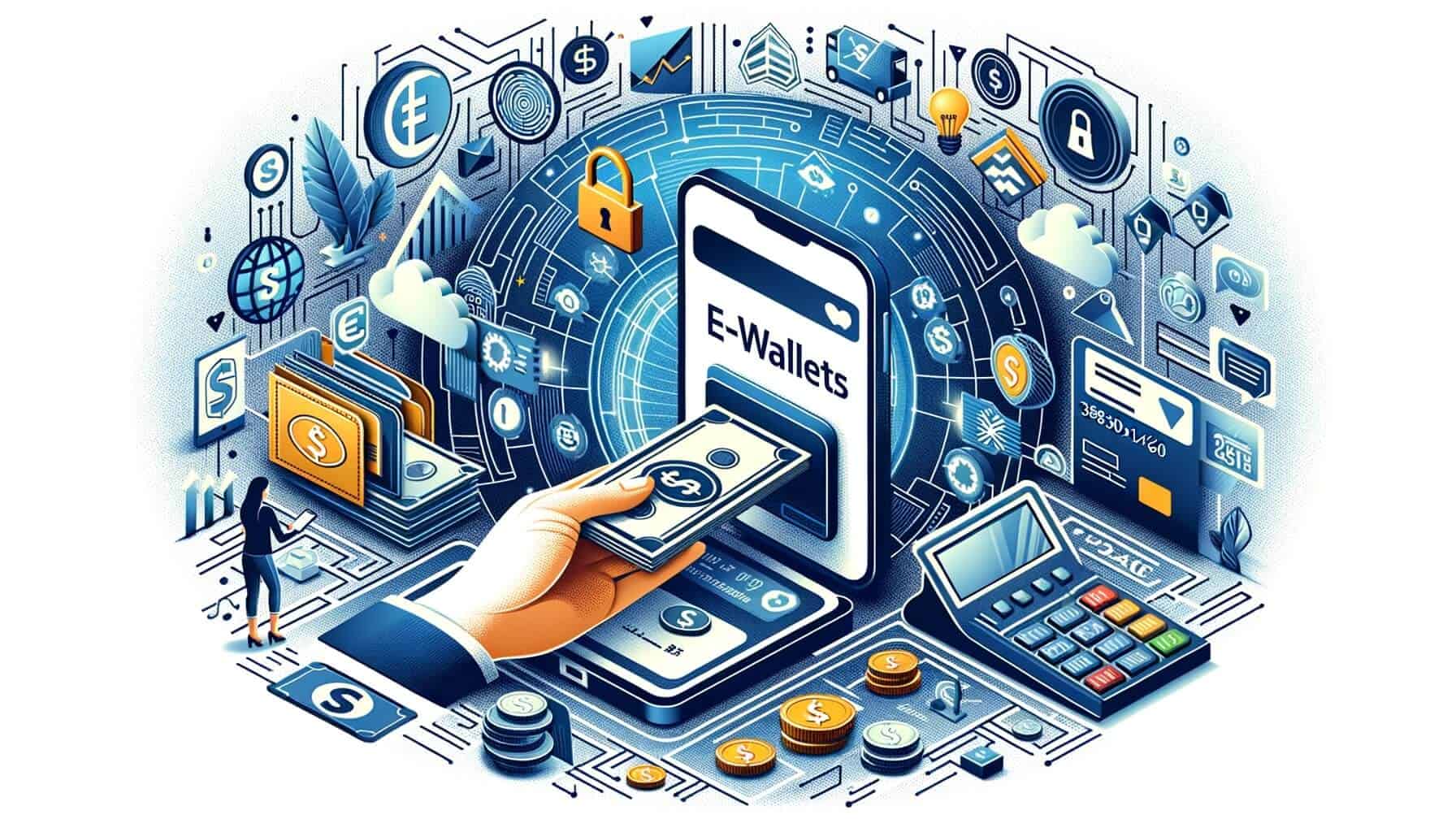
By Harriet Forster January 16, 2025
In today’s digital age, the way we handle money has undergone a significant transformation. Gone are the days when physical cash was the only means of making transactions. With the advent of technology, electronic wallets, or e-wallets, have emerged as a convenient and secure alternative to traditional payment methods. In this article, we will delve into the world of e-wallets, exploring what they are and how they work.
An e-wallet, also known as a digital wallet or mobile wallet, is a virtual storage space that allows users to store their payment information securely. It acts as a bridge between the user’s bank account or credit card and the merchant’s payment gateway, facilitating seamless transactions. E-wallets can be accessed through various devices, including smartphones, tablets, and computers, making them highly accessible and user-friendly.
Understanding the Technology Behind E-Wallets: A Detailed Overview

To comprehend how e-wallets work, it is essential to understand the underlying technology that powers them. E-wallets rely on a combination of encryption, tokenization, and secure servers to ensure the safety and integrity of users’ financial information.
Encryption plays a crucial role in safeguarding sensitive data during transmission. When a user initiates a transaction, the e-wallet encrypts the payment details, converting them into an unreadable format. This encrypted data is then securely transmitted to the merchant’s payment gateway, where it is decrypted and processed.
Tokenization is another key technology used in e-wallets. It involves replacing sensitive payment information, such as credit card numbers, with unique tokens. These tokens act as placeholders, representing the actual data without exposing it. By using tokens, e-wallets minimize the risk of data breaches and unauthorized access to users’ financial information.
Secure servers form the backbone of e-wallet technology. These servers store and process users’ payment information, ensuring that it remains protected from external threats. E-wallet providers employ robust security measures, such as firewalls, intrusion detection systems, and data encryption, to safeguard the servers and the data they contain.
Setting Up an E-Wallet: Step-by-Step Guide for Beginners

Now that we have a basic understanding of e-wallets and their underlying technology, let’s explore how to set up an e-wallet. The process may vary slightly depending on the e-wallet provider, but the general steps remain consistent.
Step 1: Choose an e-wallet provider: There are numerous e-wallet providers available in the market, each offering unique features and benefits. Research different providers and select the one that best suits your needs.
Step 2: Download the e-wallet app: Once you have chosen a provider, visit their website or app store to download the e-wallet app. Ensure that the app is compatible with your device’s operating system.
Step 3: Install and launch the app: After downloading the app, install it on your device and launch it. You will be prompted to create an account.
Step 4: Create an account: To create an account, you will need to provide some personal information, such as your name, email address, and phone number. Some e-wallet providers may also require additional verification steps, such as linking your bank account or providing identification documents.
Step 5: Set a secure password: Choose a strong and unique password for your e-wallet account. Avoid using easily guessable passwords and consider enabling two-factor authentication for added security.
Step 6: Add payment methods: Once your account is set up, you can add your preferred payment methods, such as credit cards or bank accounts, to your e-wallet. This will allow you to fund your e-wallet and make payments seamlessly.
Step 7: Verify your account: Depending on the e-wallet provider, you may need to verify your account before you can start using it. This verification process typically involves confirming your email address or phone number.
Step 8: Familiarize yourself with the app: Take some time to explore the features and functionalities of the e-wallet app. Familiarize yourself with how to navigate through the app, add funds, and make payments.
Exploring Different Types of E-Wallets: Which one is right for you?

E-wallets come in various types, each catering to different user preferences and needs. Let’s explore some of the most common types of e-wallets and their distinguishing features.
1. Closed e-wallets: Closed e-wallets are typically offered by specific merchants or service providers. They are designed to be used exclusively within the merchant’s ecosystem, allowing users to make payments for goods or services offered by that particular merchant. Closed e-wallets often offer loyalty programs and discounts to incentivize users to make purchases within their network.
2. Open e-wallets: Open e-wallets, on the other hand, are not tied to a specific merchant or service provider. They allow users to store multiple payment methods and make transactions with a wide range of merchants. Open e-wallets offer greater flexibility and convenience, as they can be used across various platforms and merchants.
3. Mobile network operator e-wallets: Mobile network operator e-wallets are provided by telecommunications companies. These e-wallets are integrated with the user’s mobile phone account, allowing them to make payments and transfer funds using their mobile balance. Mobile network operator e-wallets are particularly popular in regions where mobile banking is prevalent.
4. Bank e-wallets: Bank e-wallets are offered by traditional financial institutions, such as banks. These e-wallets are linked directly to the user’s bank account, allowing them to make payments and manage their finances seamlessly. Bank e-wallets often offer additional features, such as budgeting tools and transaction history tracking.
When choosing an e-wallet, consider factors such as the availability of merchants, security features, user interface, and customer support. Select the e-wallet that aligns with your needs and preferences to ensure a smooth and satisfactory user experience.
How to Add Funds to Your E-Wallet: A Comprehensive Guide
Once you have set up your e-wallet, the next step is to add funds to it. Adding funds to your e-wallet is a straightforward process that can be done through various methods. Let’s explore some common ways to add funds to your e-wallet.
1. Bank transfer: One of the most common methods to add funds to an e-wallet is through a bank transfer. To do this, you will need to link your bank account to your e-wallet. Once linked, you can initiate a bank transfer from your bank account to your e-wallet. The funds will be credited to your e-wallet within a specified timeframe, depending on the e-wallet provider and your bank’s processing time.
2. Credit or debit card: Many e-wallets allow users to add funds using their credit or debit cards. To add funds using this method, you will need to provide your card details, such as the card number, expiration date, and CVV code. The e-wallet will securely process the payment and credit the funds to your account.
3. Cash deposit: Some e-wallet providers offer the option to add funds through cash deposits. This method is particularly useful for users who prefer to use physical cash. To add funds through a cash deposit, you will need to visit a designated cash deposit location, such as a bank branch or a partner retail store. Provide the necessary details, such as your e-wallet account number, and deposit the desired amount in cash. The funds will be added to your e-wallet account once the deposit is processed.
4. Peer-to-peer transfer: Certain e-wallets allow users to add funds through peer-to-peer transfers. This method involves transferring funds from another user’s e-wallet to your own. To initiate a peer-to-peer transfer, you will need to provide the recipient’s e-wallet ID or mobile number. Once the transfer is authorized, the funds will be credited to your e-wallet.
It is important to note that each e-wallet provider may have specific guidelines and limitations regarding adding funds. Familiarize yourself with the options available and choose the method that best suits your needs and preferences.
Making Payments with E-Wallets: Step-by-Step Process
Now that you have funds in your e-wallet, let’s explore how to make payments using your e-wallet. Making payments with e-wallets is a simple and convenient process that can be done in a few easy steps.
Step 1: Select the payment method: When making a purchase, choose the e-wallet as your preferred payment method. This option is typically available during the checkout process on the merchant’s website or app.
Step 2: Authenticate the transaction: Depending on the e-wallet provider and the security settings you have enabled, you may need to authenticate the transaction. This can be done through various methods, such as entering a PIN, using biometric authentication (e.g., fingerprint or facial recognition), or receiving a one-time password (OTP) via SMS or email.
Step 3: Confirm the payment: Once the transaction is authenticated, review the payment details and confirm the payment. Double-check the amount and ensure that it is correct before proceeding.
Step 4: Receive payment confirmation: After the payment is processed, you will receive a payment confirmation from both the e-wallet provider and the merchant. This confirmation may be in the form of an email, SMS, or notification within the e-wallet app.
Making payments with e-wallets offers several advantages over traditional payment methods. E-wallets provide a faster and more convenient checkout experience, as users do not need to enter their payment details manually for each transaction. Additionally, e-wallets often offer features such as transaction history tracking and digital receipts, making it easier for users to manage their finances.
Ensuring Security and Privacy with E-Wallets: Best Practices
Security and privacy are paramount when it comes to e-wallets. To ensure the safety of your financial information and protect yourself from potential threats, it is essential to follow best practices. Let’s explore some key practices to enhance the security and privacy of your e-wallet.
1. Choose a reputable e-wallet provider: Select an e-wallet provider with a proven track record of security and reliability. Research the provider’s security measures, certifications, and user reviews to make an informed decision.
2. Enable two-factor authentication (2FA): Two-factor authentication adds an extra layer of security to your e-wallet account. Enable 2FA and choose a strong authentication method, such as biometric authentication or OTPs, to protect your account from unauthorized access.
3. Use strong and unique passwords: Create a strong and unique password for your e-wallet account. Avoid using easily guessable passwords and consider using a password manager to securely store and manage your passwords.
4. Keep your e-wallet app up to date: Regularly update your e-wallet app to ensure that you have the latest security patches and bug fixes. Outdated apps may have vulnerabilities that can be exploited by hackers.
5. Be cautious of phishing attempts: Be vigilant of phishing attempts, where attackers try to trick you into revealing your e-wallet login credentials or other sensitive information. Avoid clicking on suspicious links or providing personal information to unverified sources.
6. Monitor your transactions: Regularly review your e-wallet transaction history to identify any unauthorized or suspicious transactions. Report any discrepancies to your e-wallet provider immediately.
7. Protect your device: Keep your device secure by using strong passwords or biometric authentication to unlock it. Install reputable antivirus software and regularly scan your device for malware or other security threats.
By following these best practices, you can significantly enhance the security and privacy of your e-wallet, ensuring a safe and worry-free digital payment experience.
E-Wallets and Mobile Banking: The Future of Digital Transactions
E-wallets have revolutionized the way we make transactions, offering a convenient and secure alternative to traditional payment methods. As technology continues to advance, e-wallets are expected to play an increasingly significant role in the future of digital transactions. Let’s explore the relationship between e-wallets and mobile banking and their potential impact on the financial landscape.
Mobile banking, which allows users to perform banking activities through their mobile devices, has gained immense popularity in recent years. E-wallets and mobile banking are closely intertwined, with many e-wallet providers offering additional banking services within their apps. Users can perform tasks such as checking account balances, transferring funds, and paying bills directly from their e-wallets.
The integration of e-wallets and mobile banking offers several advantages. Users can access their financial information and make transactions on the go, without the need for physical banking infrastructure. This convenience has made mobile banking and e-wallets particularly popular among the younger generation, who value speed, accessibility, and flexibility in their financial transactions.
Furthermore, the rise of e-wallets and mobile banking has contributed to financial inclusion, particularly in underserved areas. Traditional banking services may be inaccessible or inconvenient for individuals in remote or rural areas. E-wallets and mobile banking provide a cost-effective and accessible solution, allowing users to manage their finances and make transactions without the need for physical bank branches.
The future of digital transactions is likely to be shaped by advancements in technology, such as the widespread adoption of blockchain and the Internet of Things (IoT). Blockchain technology, with its decentralized and transparent nature, has the potential to enhance the security and efficiency of e-wallet transactions. IoT devices, such as smartwatches and connected cars, can be integrated with e-wallets, enabling seamless and secure payments in various contexts.
As e-wallets and mobile banking continue to evolve, it is crucial for regulators and industry stakeholders to collaborate and establish robust frameworks to ensure consumer protection, privacy, and security. By fostering innovation while maintaining a strong regulatory environment, e-wallets and mobile banking can drive financial inclusion and empower individuals to participate in the digital economy.
Frequently Asked Questions (FAQs) about E-Wallets: Answered
Q.1: Are e-wallets safe to use?
Yes, e-wallets are generally safe to use. They employ advanced encryption and security measures to protect your financial information. However, it is essential to choose a reputable e-wallet provider and follow best practices, such as setting up strong passwords and enabling additional security features.
Q.2: Can I use multiple e-wallets?
Yes, you can use multiple e-wallets simultaneously. However, it is important to manage your e-wallets responsibly and keep track of your transactions and balances across different platforms.
Q.3: Can I use e-wallets for international transactions?
Yes, many e-wallets support international transactions. However, it is advisable to check the availability and acceptance of your chosen e-wallet in the specific country or region where you intend to use it.
Q.4: Are there any fees associated with e-wallets?
Some e-wallet providers may charge fees for certain transactions or services. These fees may include currency conversion fees, withdrawal fees, or transaction fees. It is recommended to review the fee structure of your chosen e-wallet provider before using their services.
Conclusion
E-wallets have transformed the way we handle our finances, offering convenience, security, and flexibility. By understanding the technology behind e-wallets, setting up an e-wallet, exploring different types, adding funds, making payments, and following best practices for security and privacy, you can fully leverage the benefits of this digital payment solution.
As technology continues to advance, e-wallets are likely to become even more prevalent, making traditional wallets a thing of the past. Embrace the future of payments with e-wallets and enjoy a seamless and secure financial experience.